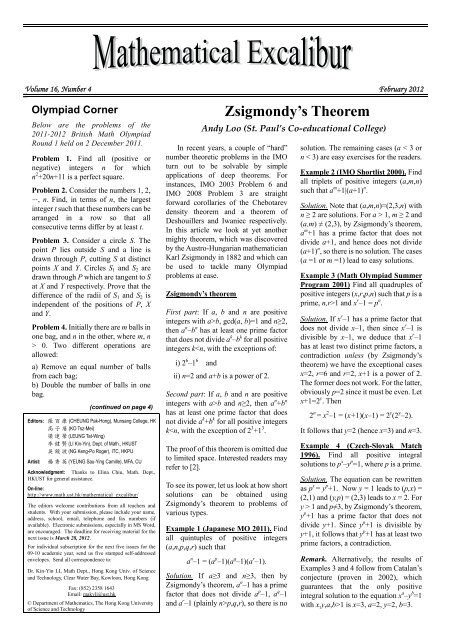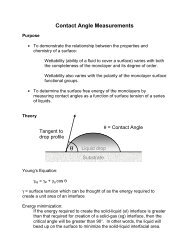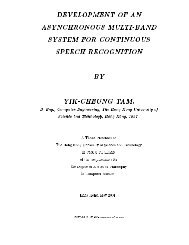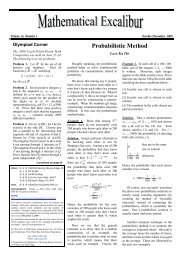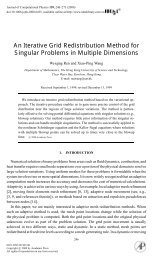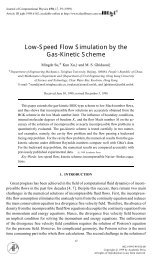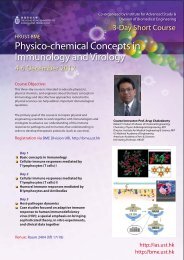Zsigmondy's Theorem - Department of Mathematics - The Hong ...
Zsigmondy's Theorem - Department of Mathematics - The Hong ...
Zsigmondy's Theorem - Department of Mathematics - The Hong ...
Create successful ePaper yourself
Turn your PDF publications into a flip-book with our unique Google optimized e-Paper software.
Volume 16, Number 4 February 2012<br />
Olympiad Corner<br />
Below are the problems <strong>of</strong> the<br />
2011-2012 British Math Olympiad<br />
Round 1 held on 2 December 2011.<br />
Problem 1. Find all (positive or<br />
negative) integers n for which<br />
n 2 +20n+11 is a perfect square.<br />
Problem 2. Consider the numbers 1, 2,<br />
⋯, n. Find, in terms <strong>of</strong> n, the largest<br />
integer t such that these numbers can be<br />
arranged in a row so that all<br />
consecutive terms differ by at least t.<br />
Problem 3. Consider a circle S. <strong>The</strong><br />
point P lies outside S and a line is<br />
drawn through P, cutting S at distinct<br />
points X and Y. Circles S 1 and S 2 are<br />
drawn through P which are tangent to S<br />
at X and Y respectively. Prove that the<br />
difference <strong>of</strong> the radii <strong>of</strong> S 1 and S 2 is<br />
independent <strong>of</strong> the positions <strong>of</strong> P, X<br />
and Y.<br />
Problem 4. Initially there are m balls in<br />
one bag, and n in the other, where m, n<br />
> 0. Two different operations are<br />
allowed:<br />
a) Remove an equal number <strong>of</strong> balls<br />
from each bag;<br />
b) Double the number <strong>of</strong> balls in one<br />
bag.<br />
(continued on page 4)<br />
Editors: 張 百 康 (CHEUNG Pak-<strong>Hong</strong>), Munsang College, HK<br />
高 子 眉 (KO Tsz-Mei)<br />
梁 達 榮 (LEUNG Tat-Wing)<br />
李 健 賢 (LI Kin-Yin), Dept. <strong>of</strong> Math., HKUST<br />
吳 鏡 波 (NG Keng-Po Roger), ITC, HKPU<br />
Artist:<br />
楊 秀 英 (YEUNG Sau-Ying Camille), MFA, CU<br />
Acknowledgment: Thanks to Elina Chiu, Math. Dept.,<br />
HKUST for general assistance.<br />
On-line:<br />
http://www.math.ust.hk/mathematical_excalibur/<br />
<strong>The</strong> editors welcome contributions from all teachers and<br />
students. With your submission, please include your name,<br />
address, school, email, telephone and fax numbers (if<br />
available). Electronic submissions, especially in MS Word,<br />
are encouraged. <strong>The</strong> deadline for receiving material for the<br />
next issue is March 28, 2012.<br />
For individual subscription for the next five issues for the<br />
09-10 academic year, send us five stamped self-addressed<br />
envelopes. Send all correspondence to:<br />
Dr. Kin-Yin LI, Math Dept., <strong>Hong</strong> Kong Univ. <strong>of</strong> Science<br />
and Technology, Clear Water Bay, Kowloon, <strong>Hong</strong> Kong<br />
Fax: (852) 2358 1643<br />
Email: makyli@ust.hk<br />
© <strong>Department</strong> <strong>of</strong> <strong>Mathematics</strong>, <strong>The</strong> <strong>Hong</strong> Kong University<br />
<strong>of</strong> Science and Technology<br />
Zsigmondy’s <strong><strong>The</strong>orem</strong><br />
Andy Loo (St. Paul’s Co-educational College)<br />
In recent years, a couple <strong>of</strong> “hard”<br />
number theoretic problems in the IMO<br />
turn out to be solvable by simple<br />
applications <strong>of</strong> deep theorems. For<br />
instances, IMO 2003 Problem 6 and<br />
IMO 2008 Problem 3 are straight<br />
forward corollaries <strong>of</strong> the Chebotarev<br />
density theorem and a theorem <strong>of</strong><br />
Deshouillers and Iwaniec respectively.<br />
In this article we look at yet another<br />
mighty theorem, which was discovered<br />
by the Austro-Hungarian mathematician<br />
Karl Zsigmondy in 1882 and which can<br />
be used to tackle many Olympiad<br />
problems at ease.<br />
Zsigmondy’s theorem<br />
First part: If a, b and n are positive<br />
integers with a>b, gcd(a, b)=1 and n≥2,<br />
then a n –b n has at least one prime factor<br />
that does not divide a k –b k for all positive<br />
integers kb and n≥2, then a n +b n<br />
has at least one prime factor that does<br />
not divide a k +b k for all positive integers<br />
kp,q,r), so there is no<br />
solution. <strong>The</strong> remaining cases (a < 3 or<br />
n < 3) are easy exercises for the readers.<br />
Example 2 (IMO Shortlist 2000). Find<br />
all triplets <strong>of</strong> positive integers (a,m,n)<br />
such that a m +1|(a+1) n .<br />
Solution. Note that (a,m,n)=(2,3,n) with<br />
n ≥ 2 are solutions. For a > 1, m ≥ 2 and<br />
(a,m) ≠ (2,3), by Zsigmondy’s theorem,<br />
a m +1 has a prime factor that does not<br />
divide a+1, and hence does not divide<br />
(a+1) n , so there is no solution. <strong>The</strong> cases<br />
(a =1 or m =1) lead to easy solutions.<br />
Example 3 (Math Olympiad Summer<br />
Program 2001) Find all quadruples <strong>of</strong><br />
positive integers (x,r,p,n) such that p is a<br />
prime, n,r>1 and x r –1 = p n .<br />
Solution. If x r –1 has a prime factor that<br />
does not divide x–1, then since x r –1 is<br />
divisible by x–1, we deduce that x r –1<br />
has at least two distinct prime factors, a<br />
contradiction unless (by Zsigmondy’s<br />
theorem) we have the exceptional cases<br />
x=2, r=6 and r=2, x+1 is a power <strong>of</strong> 2.<br />
<strong>The</strong> former does not work. For the latter,<br />
obviously p=2 since it must be even. Let<br />
x+1=2 y . <strong>The</strong>n<br />
2 n = x 2 –1 = (x+1)(x–1) = 2 y (2 y –2).<br />
It follows that y=2 (hence x=3) and n=3.<br />
Example 4 (Czech-Slovak Match<br />
1996). Find all positive integral<br />
solutions to p x –y p =1, where p is a prime.<br />
Solution. <strong>The</strong> equation can be rewritten<br />
as p x = y p +1. Now y = 1 leads to (p,x) =<br />
(2,1) and (y,p) = (2,3) leads to x = 2. For<br />
y > 1 and p≠3, by Zsigmondy’s theorem,<br />
y p +1 has a prime factor that does not<br />
divide y+1. Since y p +1 is divisible by<br />
y+1, it follows that y p +1 has at least two<br />
prime factors, a contradiction.<br />
Remark. Alternatively, the results <strong>of</strong><br />
Examples 3 and 4 follow from Catalan’s<br />
conjecture (proven in 2002), which<br />
guarantees that the only positive<br />
integral solution to the equation x a –y b =1<br />
with x,y,a,b>1 is x=3, a=2, y=2, b=3.
Mathematical Excalibur, Vol. 16, No. 4, Feb. 12 Page 2<br />
Example 5 (Polish MO 2010 Round<br />
1). Let p and q be prime numbers with<br />
q>p>2. Prove that 2 pq –1 has at least<br />
three distinct prime factors.<br />
Solution. Note that 2 p –1 and 2 q –1<br />
divide 2 pq –1. By Zsigmondy’s theorem,<br />
2 pq –1 has a prime factor p 1 that does<br />
not divide 2 p –1 and 2 q –1. Moreover,<br />
2 q –1 has a prime factor p 2 that does not<br />
divide 2 p –1. Finally, 2 p –1 has a prime<br />
factor p 3 .<br />
<strong>The</strong> next example illustrates a more<br />
involved technique <strong>of</strong> applying<br />
Zsigmondy’s theorem to solve a class<br />
<strong>of</strong> Diophantine equations.<br />
Example 6 (Balkan MO 2009). Solve<br />
the equation 5 x – 3 y = z 2 in positive<br />
integers.<br />
Solution. By considering (mod 3), we<br />
see that x must be even. Let x=2w.<br />
<strong>The</strong>n 3 y = 5 2w –z 2 = (5 w –z)(5 w +z). Note<br />
that<br />
(5 w –z,5 w +z) = (5 w –z,2z)<br />
= (5 w –z,z)<br />
= (5 w ,z) = 1,<br />
so 5 w – z = 1 and 5 w + z = 3 a for some<br />
positive integer a ≥ 2. Adding, 2(5 w ) =<br />
3 a + 1. For a = 2, we have w = 1,<br />
corresponding to the solution x = 2, y =<br />
2 and z = 4. For a ≥ 3, by Zsigmondy’s<br />
theorem, 3 a +1 has a prime factor p that<br />
does not divide 3 2 + 1 = 10, which<br />
implies p≠2 or 5, so there is no<br />
solution in this case.<br />
Example 7. Find all positive integral<br />
solutions to p a –1=2 n (p–1), where p is a<br />
prime.<br />
Solution. <strong>The</strong> case p=2 is trivial.<br />
Assume p is odd. If a is not a prime, let<br />
a=uv. <strong>The</strong>n p u –1 has a prime factor that<br />
does not divide p–1. Since p u –1<br />
divides p a –1=2 n (p–1), this prime factor<br />
<strong>of</strong> p u –1 must be 2. But by Zsigmondy’s<br />
theorem, p a –1 has a prime factor that<br />
does not divide p u –1 and p–1, a<br />
contradiction to the equation. So a is a<br />
prime. <strong>The</strong> case a=2 yields p=2 n –1, i.e.<br />
the Mersenne primes. If a is an odd<br />
number, then by Zsigmondy’s theorem<br />
again, p a –1=2 n (p–1) has a prime factor<br />
that does not divide p–1; this prime<br />
factor must be 2. However, 2 divides<br />
p–1, a contradiction.<br />
(continued on page 4)<br />
A Geometry <strong><strong>The</strong>orem</strong><br />
Kin Y. Li<br />
<strong>The</strong> following is a not so well known,<br />
but useful theorem.<br />
A<br />
α β<br />
Solution. Let ∠BAC=∠DAC=θ and<br />
G’ be on segment BC such that<br />
∠G’AC =∠EAC=α. We will show G’,<br />
F, D are collinear, which implies G’=G.<br />
Applying the subtended angle theorem<br />
to △ABE, △ABC and △ACD<br />
respectively, we get<br />
(1)<br />
sin( θ + α ) sinα<br />
sinθ<br />
= + ,<br />
B D C<br />
AF AB AE<br />
Subtended Angle <strong><strong>The</strong>orem</strong>. D is a point<br />
inside ∠BAC (
Mathematical Excalibur, Vol. 16, No. 4, Feb. 12 Page 3<br />
Problem Corner<br />
We welcome readers to submit their<br />
solutions to the problems posed below<br />
for publication consideration. <strong>The</strong><br />
solutions should be preceded by the<br />
solver’s name, home (or email) address<br />
and school affiliation. Please send<br />
submissions to Dr. Kin Y. Li,<br />
<strong>Department</strong> <strong>of</strong> <strong>Mathematics</strong>, <strong>The</strong> <strong>Hong</strong><br />
Kong University <strong>of</strong> Science &<br />
Technology, Clear Water Bay, Kowloon,<br />
<strong>Hong</strong> Kong. <strong>The</strong> deadline for sending<br />
solutions is March 28, 2012.<br />
Problem 386. Observe that 7+1=2 3<br />
and 7 7 +1= 2 3 ×113×911. Prove that for<br />
n = 2, 3, 4,…, in the prime factorization<br />
<strong>of</strong> A = 7 7 n<br />
n<br />
+1 , the sum <strong>of</strong> the<br />
exponents is at least 2n+3.<br />
Problem 387. Determine (with pro<strong>of</strong>)<br />
all functions f : [0,+∞) →[0,+∞) such<br />
that for every x ≥ 0, we have 4f(x) ≥ 3x<br />
and f (4f(x) − 3x) = x.<br />
Problem 388. In ΔABC, ∠BAC=30°<br />
and ∠ABC=70°. <strong>The</strong>re is a point M<br />
lying inside ΔABC such that ∠MAB=<br />
∠MCA=20°. Determine ∠MBA (with<br />
pro<strong>of</strong>).<br />
Problem 389. <strong>The</strong>re are 80 cities. An<br />
airline designed flights so that for each<br />
<strong>of</strong> these cities, there are flights going in<br />
both directions between that city and at<br />
least 7 other cities. Also, passengers<br />
from any city may fly to any other city<br />
by a sequence <strong>of</strong> these flights.<br />
Determine the least k such that no<br />
matter how the flights are designed<br />
subject to the conditions above,<br />
passengers from one city can fly to<br />
another city by a sequence <strong>of</strong> at most k<br />
flights.<br />
Problem 390. Determine (with pro<strong>of</strong>)<br />
all ordered triples (x, y, z) <strong>of</strong> positive<br />
integers satisfying the equation<br />
x 2 y 2 = z 2 (z 2 − x 2 − y 2 ).<br />
*****************<br />
Solutions<br />
****************<br />
Problem 381. Let k be a positive<br />
integer. <strong>The</strong>re are 2 k balls divided into<br />
a number <strong>of</strong> piles. For every two piles<br />
A and B with p and q balls respectively,<br />
if p ≥ q, then we may transfer q balls<br />
from pile A to pile B. Prove that it is<br />
always possible to make finitely many<br />
such transfers so as to have all the balls<br />
end up in one pile.<br />
Solution. AN-anduud Problem Solving<br />
Group (Ulaanbaatar, Mongolia), CHAN<br />
Chun Wai and LEE Chi Man (Statistics<br />
and Actuarial Science Society SS<br />
HKUSU), Andrew KIRK (Mearns<br />
Castle High School, Glasgow, Scotland),<br />
Kevin LAU Chun Ting (St. Paul’s<br />
Co-educational College, S.3), LO Shing<br />
Fung (F3E, Carmel Alison Lam<br />
Foundation Secondary School) and Andy<br />
LOO (St. Paul’s Co-educational College).<br />
We induct on k. For k=1, we can merge<br />
the 2 balls in at most 1 transfer.<br />
Suppose the case k=n is true. For k=n+1,<br />
since 2 k is even, considering (odd-even)<br />
parity <strong>of</strong> the number <strong>of</strong> balls in each pile,<br />
we see the number <strong>of</strong> piles with odd<br />
numbers <strong>of</strong> balls is even. Pair up these<br />
piles. In each pair, after 1 transfer, both<br />
piles will result in even number <strong>of</strong> balls.<br />
So we need to consider only the situation<br />
when all piles have even number <strong>of</strong> balls.<br />
<strong>The</strong>n in each pile, pair up the balls. This<br />
gives altogether 2 n pairs. Applying the<br />
case k=n with the paired balls, we solve<br />
the case k=n+1.<br />
Problem 382. Let v 0 = 0, v 1 = 1 and<br />
v n+1 = 8v n −v n−1 for n = 1,2,3,….<br />
Prove that v n is divisible by 3 if and only if<br />
v n is divisible by 7.<br />
Solution. Alumni 2011 (Carmel Alison<br />
Lam Foundation Secondary School) and<br />
AN-anduud Problem Solving Group<br />
(Ulaanbaatar, Mongolia) and Mihai<br />
STOENESCU (Bischwiller, France).<br />
For n = 1,2,3,…, v n+2 = 8(8v n −v n−1 ) −v n =<br />
63v n − 8v n−1 . <strong>The</strong>n v n+2 ≡ v n−1 (mod 3) and<br />
v n+2 ≡ −v n−1 (mod 7). Since v 0 = 0, v 1 =1, v 2 =<br />
8, so v 3k+1 , v 3k+2 ≢ 0 (mod 3) and (mod 7)<br />
and v 3k ≡ 0 (mod 3) and (mod 7).<br />
Other commended solvers: CHAN Chun<br />
Wai and LEE Chi Man (Statistics and<br />
Actuarial Science Society SS HKUSU),<br />
CHAN Long Tin (Diocesan Boys’<br />
School), CHAN Yin <strong>Hong</strong> (St. Paul’s<br />
Co-educational College), Andrew KIRK<br />
(Mearns Castle High School, Glasgow,<br />
Scotland), Kevin LAU Chun Ting (St.<br />
Paul’s Co-educational College, S.3), LKL<br />
Excalibur (Madam Lau Kam Lung<br />
Secondary School <strong>of</strong> MFBM), Andy<br />
LOO (St. Paul’s Co-educational College),<br />
NGUYEN van Thien (Luong <strong>The</strong> Vinh<br />
High School, Dong Nai, Vietnam), O Kin<br />
Chit Alex (G.T.(Ellen Yeung) College),<br />
Ángel PLAZA (Universidad de Las<br />
Palmas de Gran Canaria, Spain), Yan Yin<br />
WANG (City University <strong>of</strong> <strong>Hong</strong> Kong,<br />
Computing Math, Year 2), ZOLBAYAR<br />
Shagdar (Orchlon School, Ulaanbaatar,<br />
Mongolia),Titu ZVONARU (Comăneşti,<br />
Romania) and Neculai STANCIU<br />
(“George Emil Palade’’ Secondary School,<br />
Buzău, Romania).<br />
Problem 383. Let O and I be the<br />
circumcenter and incenter <strong>of</strong> ΔABC<br />
respectively. If AB≠AC, points D, E are<br />
midpoints <strong>of</strong> AB, AC respectively and<br />
BC=(AB+AC)/2, then prove that the<br />
line OI and the bisector <strong>of</strong> ∠CAB are<br />
perpendicular.<br />
Solution 1. Kevin LAU Chun Ting (St.<br />
Paul’s Co-educational College, S.3).<br />
C<br />
F<br />
O<br />
E<br />
I<br />
From BC = (AB+AC)/2 = BD+CE, we<br />
see there exists a point F be on side BC<br />
such that BF=BD and CF=CE. Since BI<br />
bisects ∠FBD, by SAS, ΔIBD≅ΔIBF.<br />
<strong>The</strong>n ∠BDI=∠BFI. Similarly, ∠CEI =<br />
∠CFI. <strong>The</strong>n<br />
B<br />
D<br />
∠ADI +∠AEI<br />
= (180°−∠BDI ) + (180°−∠CEI )<br />
= 360° −∠BFI −∠CFI = 180°.<br />
So A,D,I,E are concyclic.<br />
Since OD ⊥ AD and OE ⊥ AE, so<br />
A,D,O,E are also conyclic. <strong>The</strong>n A,D,I,O<br />
are concyclic. So ∠OIA =∠ODA=90°.<br />
Solution 2. AN-anduud Problem<br />
Solving Group (Ulaanbaatar,<br />
Mongolia), Ercole SUPPA (Teramo,<br />
Italy), Titu ZVONARU (Comăneşti,<br />
Romania) and Neculai STANCIU<br />
(“George Emil Palade’’ Secondary<br />
School, Buzău, Romania).<br />
Let a=BC, b=CA, c=AB and let R, r, s be<br />
the circumradius, the inradius and the<br />
semiperimeter <strong>of</strong> ΔABC respectively.<br />
By the famous formulas OI 2 = R 2 −2Rr,<br />
s−a = AI cos(A/2), Rr = abc/(4s) and<br />
cos 2 (A/2) = s(s−a)/(bc), we get<br />
AI<br />
2<br />
2<br />
( s − a)<br />
bc(<br />
s − a)<br />
= = ,<br />
2<br />
cos ( A/<br />
2) s<br />
2 2<br />
2 abc<br />
OI = R − 2Rr<br />
= R − .<br />
2s<br />
If a = (b+c)/2, then we get 2s = 3a and<br />
bc(s−a)/s = abc/(2s). So AI 2 +OI 2 = R 2 =<br />
OA 2 . By the converse <strong>of</strong> Pythagoras’<br />
<strong><strong>The</strong>orem</strong>, we get OI⊥AI.<br />
Comment: In the last paragraph, all<br />
steps may be reversed so that OI⊥AI if<br />
and only if a = (b+c)/2.<br />
A
Mathematical Excalibur, Vol. 16, No. 4, Feb. 12 Page 4<br />
Other commended solvers: Alumni<br />
2011 (Carmel Alison Lam Foundation<br />
Secondary School), CHAN Chun Wai<br />
and LEE Chi Man (Statistics and<br />
Actuarial Science Society SS HKUSU),<br />
Andrew KIRK (Mearns Castle High<br />
School, Glasgow, Scotland), Andy<br />
LOO (St. Paul’s Co-educational<br />
College), MANOLOUDIS Apostolos<br />
(4° Lyk. Korydallos, Piraeus, Greece),<br />
NGUYEN van Thien (Luong <strong>The</strong><br />
Vinh High School, Dong Nai, Vietnam),<br />
Mihai STOENESCU (Bischwiller,<br />
France) and ZOLBAYAR Shagdar<br />
(Orchlon School, Ulaanbaatar,<br />
Mongolia).<br />
Problem 384. For all positive real<br />
numbers a,b,c satisfying a + b + c = 3,<br />
prove that<br />
2 2 2 2 2 2<br />
a + 3b<br />
b + 3c<br />
c + 3a<br />
+ + ≥4.<br />
2<br />
2<br />
2<br />
ab (4−ab)<br />
bc (4−bc)<br />
ca (4−ca)<br />
Solution. William PENG.<br />
Let<br />
a b c<br />
A=<br />
+ + ,<br />
2<br />
2<br />
2<br />
b (4−ab)<br />
c (4−bc)<br />
a (4−ca)<br />
1 1 1<br />
B=<br />
+ + ,<br />
a(4<br />
−ab)<br />
b(4<br />
−bc)<br />
c(4<br />
−ca)<br />
4−ab<br />
4−bc<br />
4−ca<br />
C=<br />
+ +<br />
a b c<br />
and D 1 1 1<br />
= + .<br />
a b<br />
+ <strong>The</strong>n A+3B is the<br />
c<br />
left side <strong>of</strong> the desired inequality. Now<br />
since a + b + c = 3, we have C = 4D −3.<br />
By the Cauchy-Schwarz inequality, we<br />
have (a+b+c)D ≥ 3 2 , AC ≥ D 2 and BC<br />
≥ D 2 . <strong>The</strong> first <strong>of</strong> these gives us D ≥ 3<br />
so that (D−3)(D−1)≥0, which implies<br />
D 2 ≥ 4D−3. <strong>The</strong> second and third imply<br />
4D<br />
A + 3B<br />
≥<br />
C<br />
2<br />
2<br />
4D<br />
= ≥ 4.<br />
4D<br />
− 3<br />
Other commended solvers: Alumni<br />
2011 (Carmel Alison Lam Foundation<br />
Secondary School), AN-anduud<br />
Problem Solving Group (Ulaanbaatar,<br />
Mongolia), Andrew KIRK (Mearns<br />
Castle High School, Glasgow,<br />
Scotland), LKL Excalibur (Madam<br />
Lau Kam Lung Secondary School <strong>of</strong><br />
MFBM), Andy LOO (St. Paul’s<br />
Co-educational College), NGUYEN<br />
van Thien (Luong <strong>The</strong> Vinh High<br />
School, Dong Nai, Vietnam) and Paolo<br />
PERFETTI (Math Dept, Università<br />
degli studi di Tor Vergata Roma, via<br />
della ricerca scientifica, Roma, Italy).<br />
Problem 385. To prepare for the IMO,<br />
in everyday <strong>of</strong> the next 11 weeks, Jack<br />
will solve at least one problem. If every<br />
week he can solve at most 12 problems,<br />
then prove that for some positive integer n,<br />
there are n consecutive days in which he<br />
can solve a total <strong>of</strong> 21 problems.<br />
Solution. AN-anduud Problem Solving<br />
Group (Ulaanbaatar, Mongolia), CHAN<br />
Chun Wai and LEE Chi Man (Statistics<br />
and Actuarial Science Society SS<br />
HKUSU), Andrew KIRK (Mearns<br />
Castle High School, Glasgow, Scotland),<br />
Andy LOO (St. Paul’s Co-educational<br />
College) and Yan Yin WANG (City<br />
University <strong>of</strong> <strong>Hong</strong> Kong, Computing<br />
Math, Year 2).<br />
Let S i be the total number <strong>of</strong> problems<br />
Jack solved from the first day to the end <strong>of</strong><br />
the i-th day. Since he solves at least one<br />
problem everyday, we have 0 < S 1 < S 2 < S 3<br />
< ⋯ < S 77 . Since he can solve at most 12<br />
problems every week, we have<br />
S 77 ≤12×11=132.<br />
Consider the two strictly increasing<br />
sequences S 1 , S 2 , ⋯ , S 77 and S 1 +21, S 2 +21,<br />
⋯, S 77 +21. Now these 154 integers are at<br />
least 1 and at most 132+21=153. By the<br />
pigeonhole principle, since the two<br />
sequences are strictly increasing, there<br />
must be m < k such that S k =S m +21.<br />
<strong>The</strong>refore, Jack solved a total <strong>of</strong> 21<br />
problems from the (m+1)-st day to the end<br />
<strong>of</strong> the k-th day.<br />
Olympiad Corner<br />
(continued from page 1)<br />
Problem 4 (cont). Is it possible to empty<br />
both bags after a finite sequence <strong>of</strong><br />
operations?<br />
Operation b) is now replaced with<br />
b') Triple the number <strong>of</strong> balls in one bag.<br />
Is it now possible to empty both bags after<br />
a finite sequence <strong>of</strong> operations?<br />
Problem 5. Prove that the product <strong>of</strong> four<br />
consecutive positive integers cannot be<br />
equal to the product <strong>of</strong> two consecutive<br />
positive integers.<br />
Problem 6. Let ABC be an acute-angled<br />
triangle. <strong>The</strong> feet <strong>of</strong> all the altitudes from<br />
A, B and C are D, E and F respectively.<br />
Prove that DE+DF ≤ BC and determine<br />
the triangles for which equality holds.<br />
Zsigmondy’s <strong><strong>The</strong>orem</strong><br />
(continued from page 2)<br />
Example 8. Find all positive integral<br />
solutions to<br />
(a+1)(a 2 +a+1)⋯(a n +a n–1 +⋯+1)<br />
= a m +a m-1 +⋯+1.<br />
Solution. Note that n = m = 1 is a trivial<br />
solution. Other than that, we must have<br />
m>n. Write the equation as<br />
2 3 n+ 1 m+<br />
1<br />
a −1 a −1 a −1<br />
a −1<br />
⋅ ⋅...<br />
⋅ = ,<br />
a−1 a−1 a−1 a−1<br />
then rearranging we get<br />
( )( ) (<br />
2 3 n+<br />
1<br />
a −1 a −1 ... a −1<br />
m+<br />
1<br />
( a )( a )<br />
n−1<br />
= −1 −1 .<br />
By Zsigmondy’s theorem, we must<br />
have a = 2 and m + 1 = 6, i.e. m = 5<br />
(otherwise, a m –1 has a prime factor that<br />
does not divide a 2 –1, a 3 –1, …, a n+1 –1,<br />
a contradiction), which however does<br />
not yield a solution for n.<br />
<strong>The</strong> above examples show that<br />
Zsigmondy’s theorem can instantly<br />
reduce many number theoretic<br />
problems to a handful <strong>of</strong> small cases.<br />
We should bear in mind the exceptions<br />
stated in Zsigmondy’s theorem in order<br />
not to miss out any solutions.<br />
Below are some exercises for the<br />
readers.<br />
Exercise 1 (1994 Romanian Team<br />
Selection Test). Prove that the<br />
sequence a n =3 n –2 n contains no three<br />
terms in geometric progression.<br />
Exercise 2. Fermat’s last theorem<br />
asserts that for a positive integer n ≥ 3,<br />
the equation x n +y n =z n has no integral<br />
solution with xyz≠0. Prove this<br />
statement when z is a prime.<br />
Exercise 3 (1996 British Math<br />
Olympiad Round 2). Determine all<br />
sets <strong>of</strong> non-negative integers x, y and z<br />
which satisfy the equation 2 x +3 y =z 2 .<br />
Reference<br />
[1] PISOLVE, <strong>The</strong> Zsigmondy<br />
<strong><strong>The</strong>orem</strong>,<br />
http://www.art<strong>of</strong>problemsolving.com/<br />
Forum/viewtopic.php?f=721&t=42233<br />
0<br />
[2] Lola Thompson, Zsigmondy’s<br />
<strong><strong>The</strong>orem</strong>,<br />
http://www.math.dartmouth.edu/~tho<br />
mpson/<strong>Zsigmondy's</strong>%20<strong><strong>The</strong>orem</strong>.pdf<br />
)


